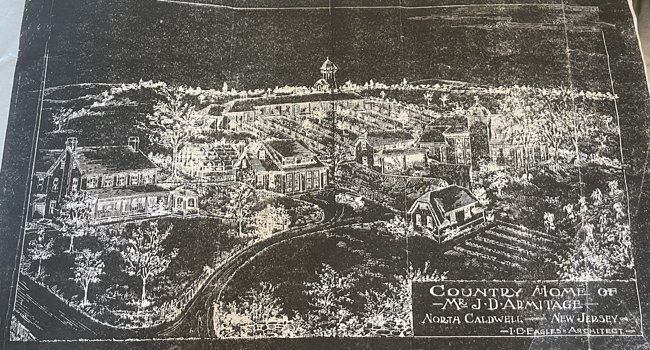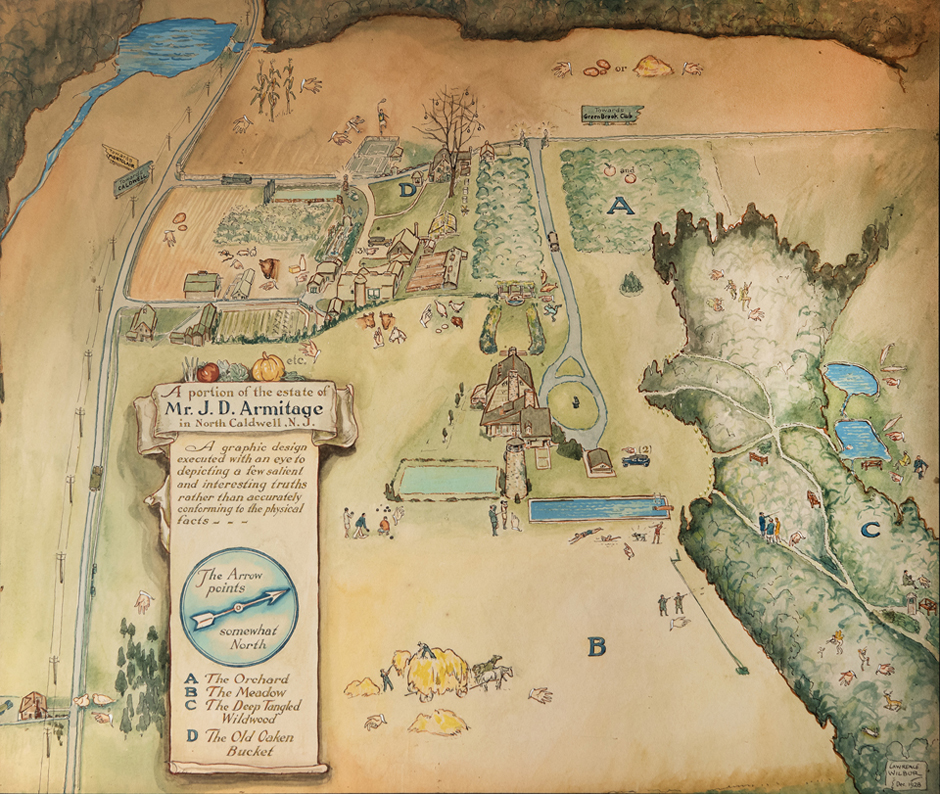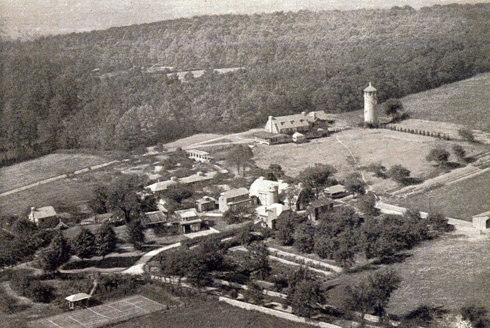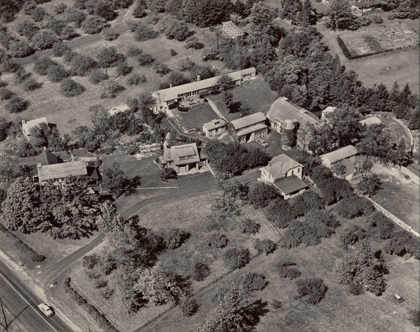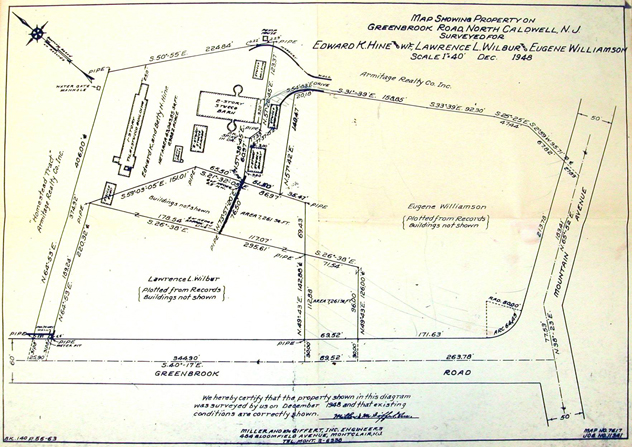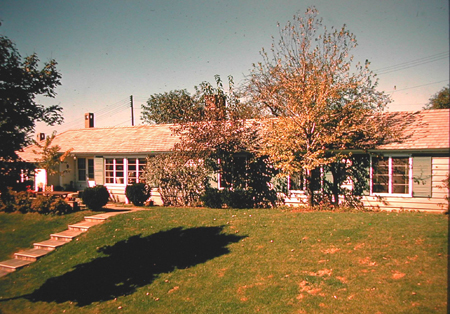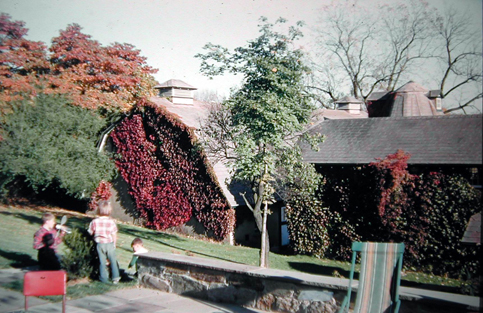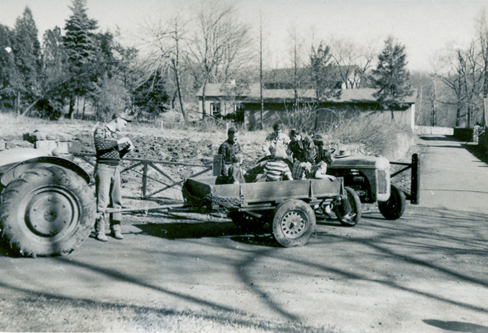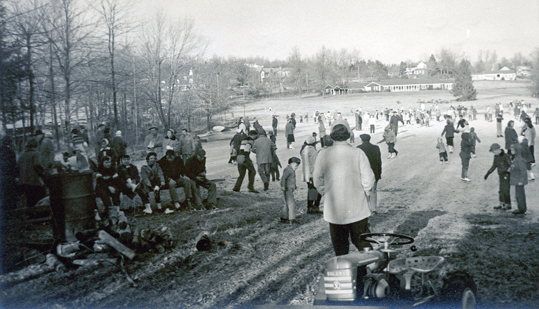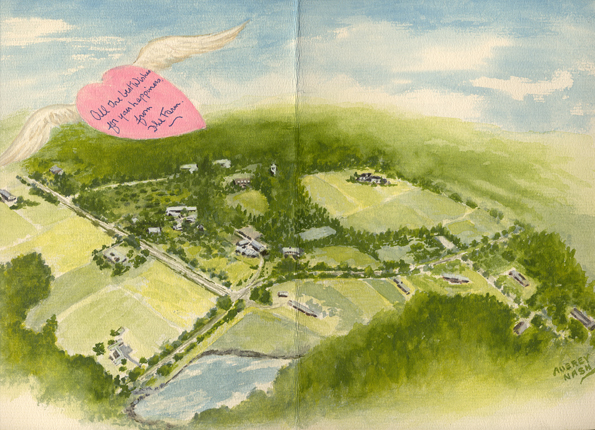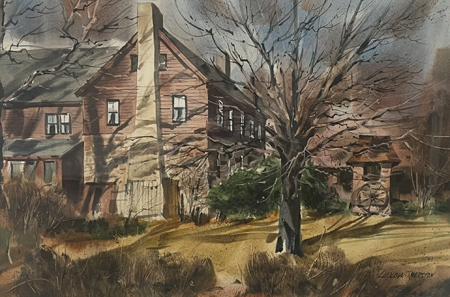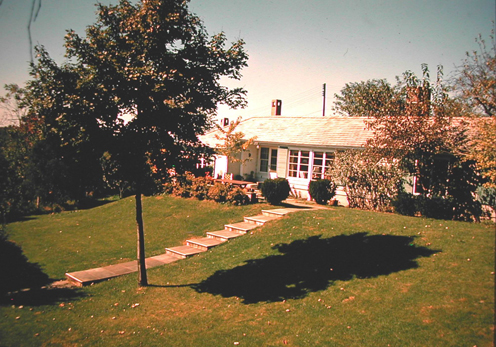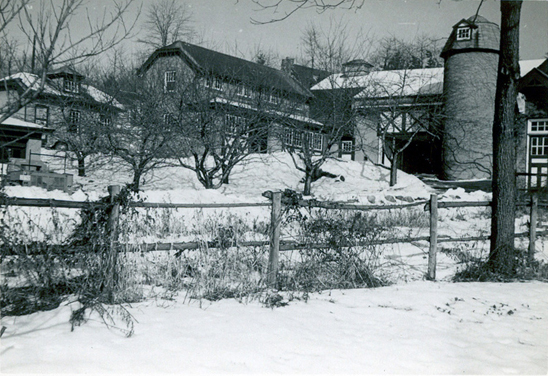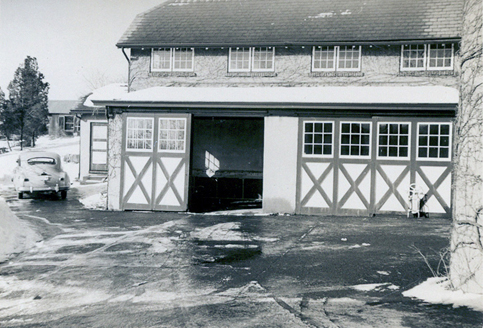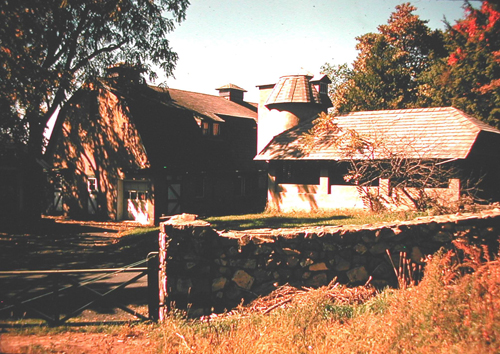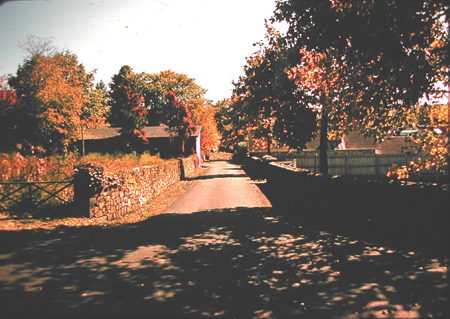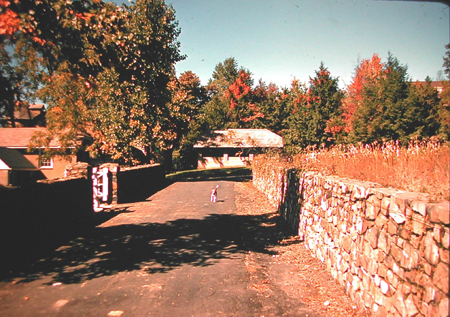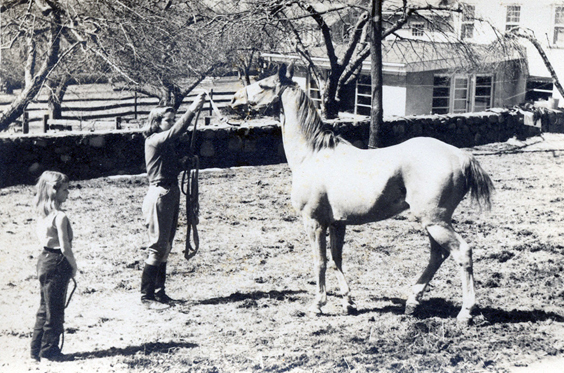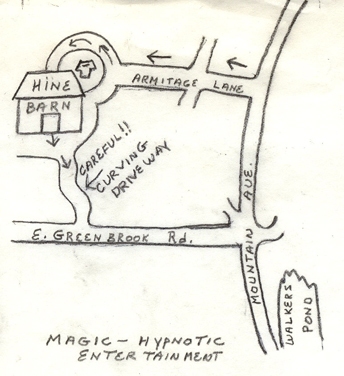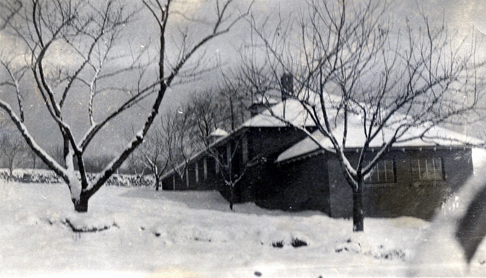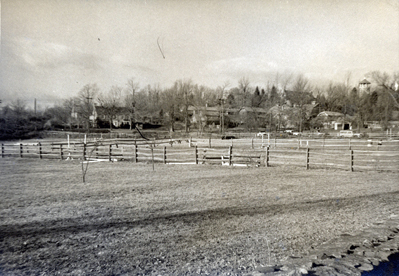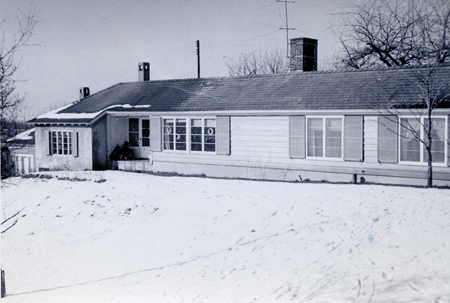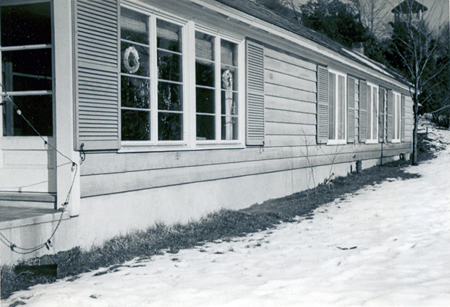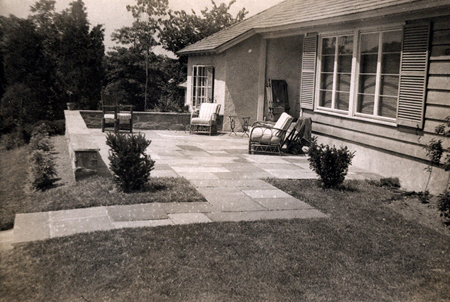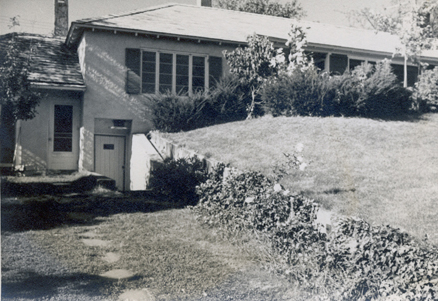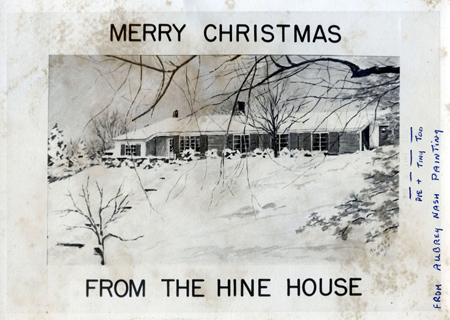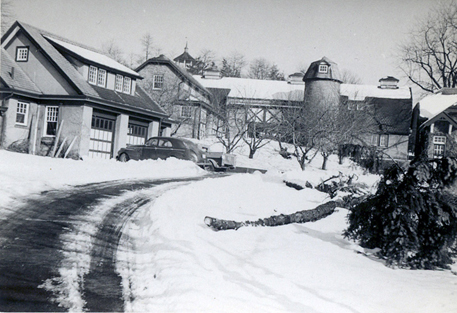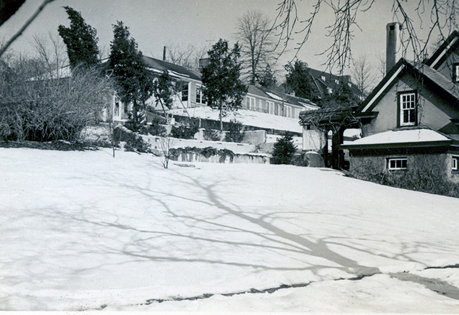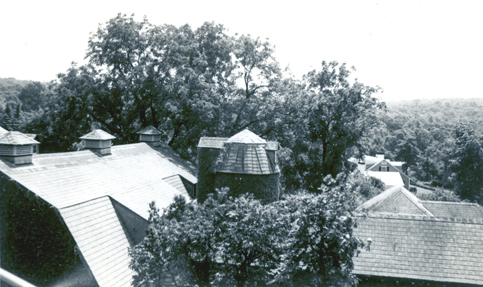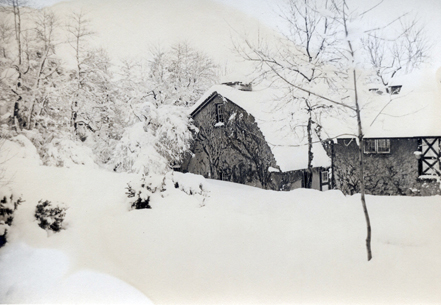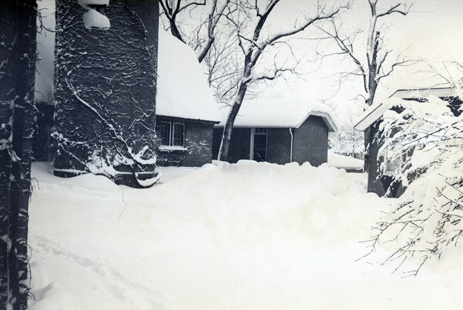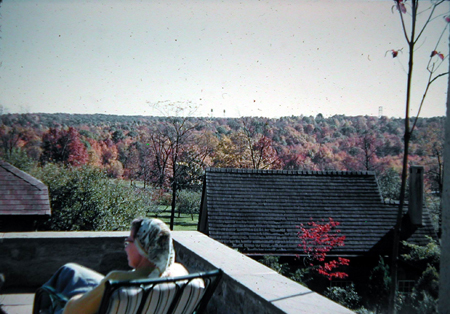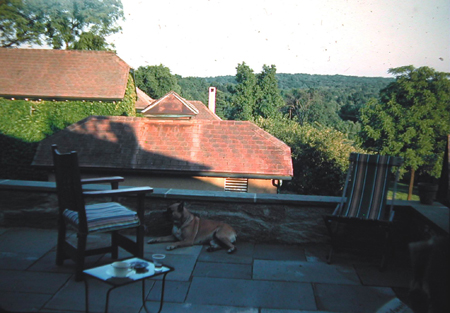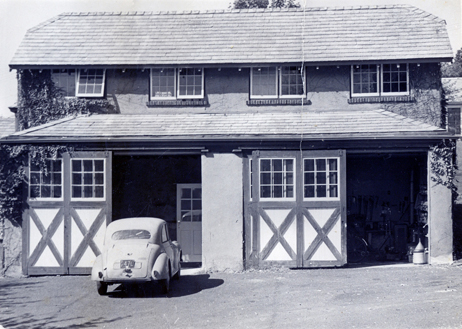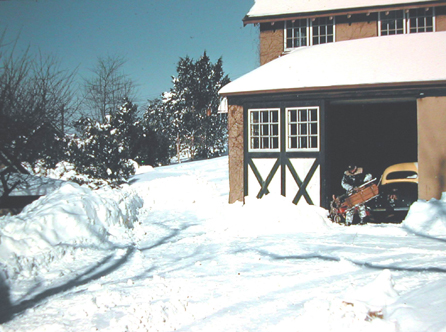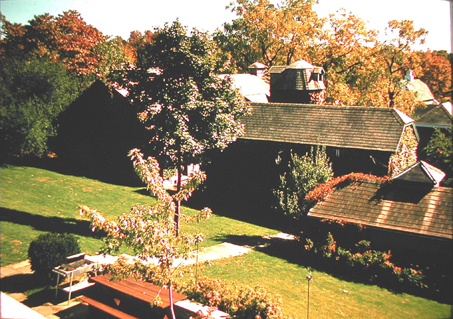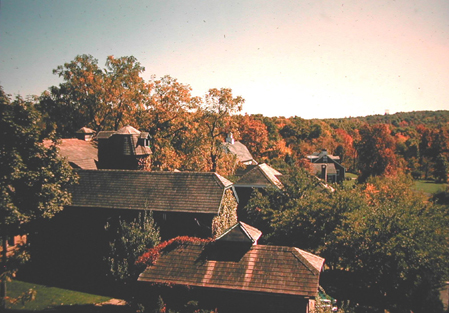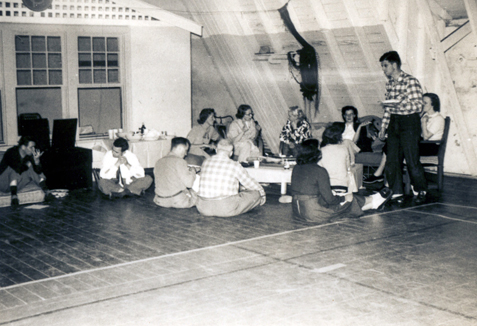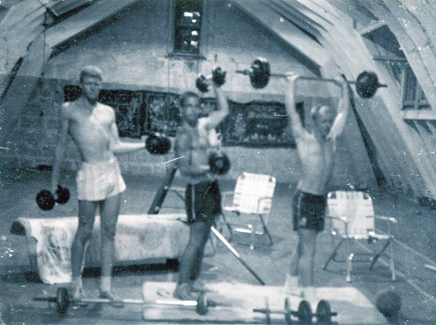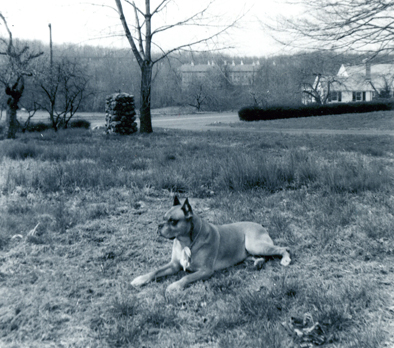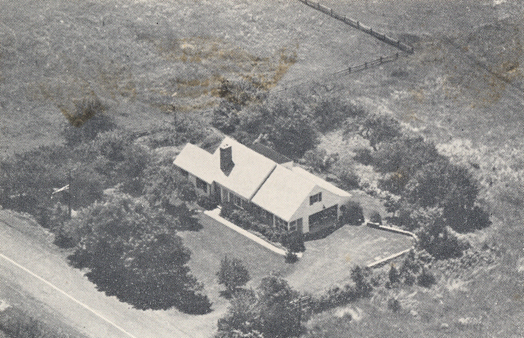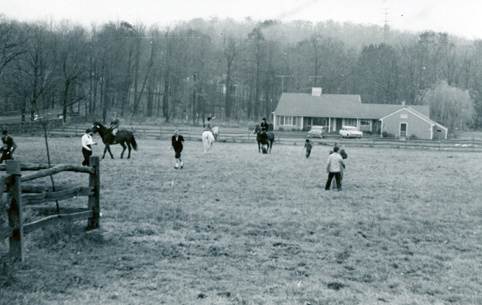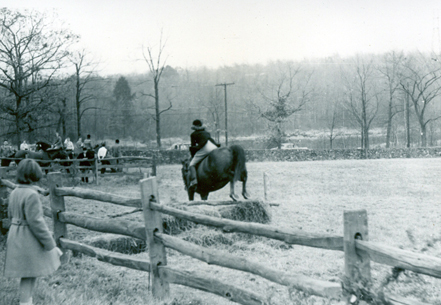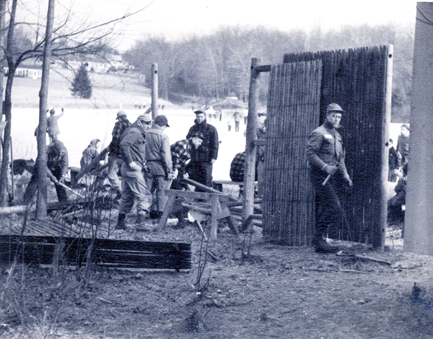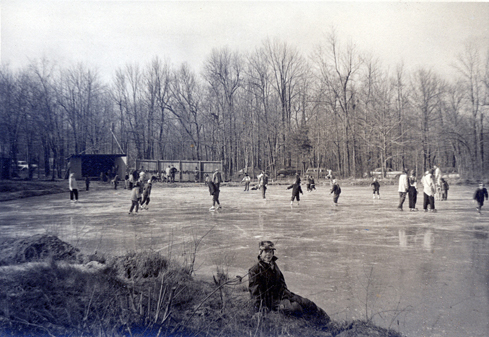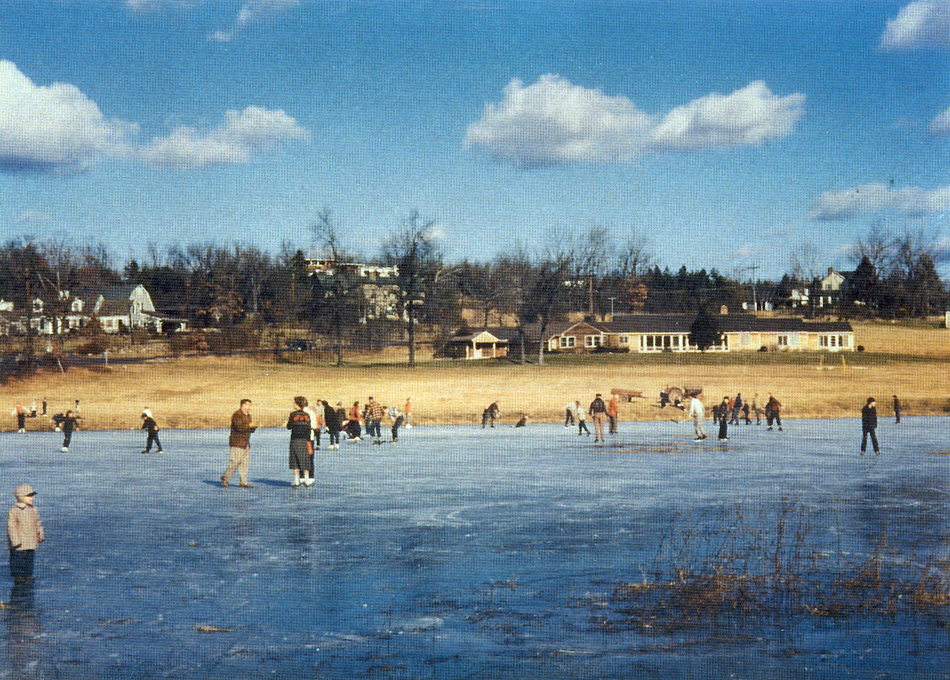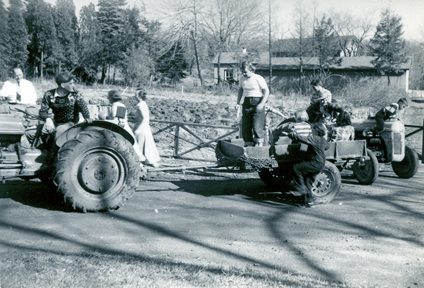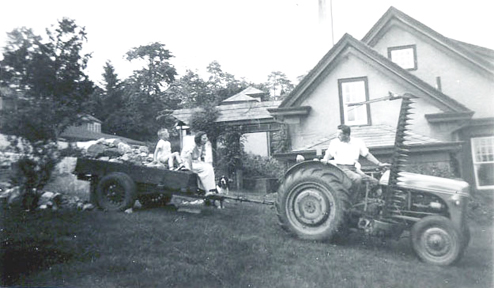|
About "The
Farm" By former resident Ted Hine -
January 2025 Introduction
I was born in the spring of 1945 and lived in North Caldwell, NJ for the first 18 years of my life, first in a rented house at the corner of Greenbrook Rd and Woodland Ave. and then, starting in Sept. of 1949 when I was 4 years old (and till 1963 at age 18) in a home on what had been the J.D. Armitage Estate and farm at the intersection of Greenbrook Rd. and Mountain Ave. My parents had come to know Mr. Armitage who lived about 1/4 mile from our rented home and in the late 1940's they purchased about 1 acre of land containing the majority of the old (and by then unused) working farm buildings from Mr. Armitage and had a nice home built in what a been the farm's chicken coop which became know to our friends and neighbors simply as "The Coop". Mr. Armitage would soon pass away but he and his heirs over a couple of years sold other parts of the former farm/estate, mostly large multi-acre lots, to others who built custom homes for their families. These families became a close knit group of neighbors who socialized together regularly and the neighborhood became known among it's residents and others in North Caldwell and nearby communities simply as "The Farm". I originally presented and documented the following in bits and pieces in the separate biographies I wrote a few years back regarding my father and mother (Kirt and Betty Hine). (See tedhine.com ) This made it difficult to see the complete story in one place for those interested in only the Armitage Estate so I've organized everything I already had here and added new information about the history of the property to aid those that might have an historic interest in the area. Many of the photos contained below from the 1950's and 1960's are from my parents photo collection. Clicking on most (but not all) photos will enlarge them. Early History Of The Property
The first know structure on what would become the J.D. Armitage Estate was built around 1775 and today still stands as a historic home known as Sandford-Stager house on Greenbrook Rd. Thomas Sandford sold the home to John Stager in 1806 whose family occupied it
till 1906 when it was purchased by Dr. S.C.G. Watkins, a dentist from
Montclair, who used it as a vacation home. In 1919 Dr. Watkins sold
the property to J.D. Armitage. An article regarding Dr. Watkins ownership
and adventures growing fruit appeared many years later in the Montclair Times in
1938.
A 1906 map of the area
shows the home but no substantial farm buildings.
About J.D. Armitage and His Estate Joshua Dickinson Armitage (1864-1949 and usually
referred to simply as J.D. Armitage) was born in England in 1864 and, according to his
New York Times obituary, emigrated to America in 1893 at about age 29. He
subsequently became very wealthy as a founder of the textile firm Taylor,
Armitage, & Eagles which had offices in New York City and which apparently owned and
managed various textile firms.
Much of what is known about J.D. Armitage's ownership of the estate comes from the well known portrait artist Lawrence (Bud) Wilbur who rented the Sandford-Stager house starting in 1923 (and eventually bought it) from Mr. Armitage and from his son Richard (Dick) Wilbur who grew up on the estate and went on to become one of the best know contemporary poets in the country, was a two time Pulitzer Prize winner, and was the second Poet Laureate to the U.S. Library of Congress. According to Richard, his father Lawrence Wilbur and family were invited by Mr. Armitage to live in the Sandford-Stager house in about 1923 when Richard was 2 years old. By this time the farm apparently was well established as a true English gentleman's estate. The elder Wilbur's would live there into the 1970's. My family's lifelong connection to the Wilburs started during World War II when Dick's new wife Charlee was living with his parents in North Caldwell while he was serving in the army in Europe. My parents lived about 1/4 mile from the Wilburs and my mother and Charlee become close friends for the rest of their lives. My first childhood playmate as an infant was the Wilbur's daughter and Charlee would serve as godmother to one of my brothers. While Richard Wilbur and his family didn't live in North Caldwell as adults after WWII, they visited the elder Wilburs there often. Richard Wilbur's recollections of the Armitage estate and growing up in North Caldwell have been preserved both in writing and captured in a video interview.
In the 4 years between 1919 when Mr.
Armitage purchased the property and 1923 when the Wilburs moved there the
landscape had been transformed and (still in place while I lived there) the
Estate consisted of a number of sturdy (overbuilt in my opinion) working farm
buildings, fields, forested areas, ponds, and fruit orchards as well as a huge
residential mansion. The working farm buildings were mostly built of
rugged stucco covered concrete and included a large barn, corn crib, hay house,
chicken coop, dairy processing facility, as well as a tall water tower on the
hill (with a observation deck on top to view the neighboring countryside).
There were a few other support structures. A pump house contained a large
one-cylinder diesel engine to pump well water up to the water tower which
provided irrigation to the farm. The ground floor of the barn was set up
for milking cows and other farm tasks but the entire second floor of the barn was configured as an
indoor badminton and/or paddle tennis court complete a with a hardwood floor and
an enclosed room at one end with windows and heaters so Mr. Armitage and his
quests could stay warm in the winter while watching matches. There was (and
still is) an entry road from Mountain Ave. to the farm buildings lined with
English style stone walls and enclosed pens which was called Armitage Lane (not
to be confused with another current nearby road with the same name). The
estate had a tennis court originally across Greenbrook Rd. from the Wilbur's (Sandford-Stager)
house but moved by the time I was there to off of Mountain Ave. There were
a number of perhaps 6 foot wide asphalt paved walking paths winding through the woods and fields so Mr.
Armitage and his guests could easily stroll around the estate. Some of these
paths, including the ones to what we called Twin Ponds, had concrete benches along
them so strollers could sit and rest. The two ponds were man made and
lined with architectural stones around the perimeters. According to a 2023 real estate
ad the mansion today consists of 12,000 square feet of living space, has 6
bedrooms, 8 baths, a gym, wine cellar, and a 5 car garage among other amenities.
In 1928 artist Lawrence Wilbur, then the occupant of the Sandford-Stager home on the property, painted a watercolor of the estate which shows its general features and extent. See the photo below.
About "The Farm" Richard Wilbur suggests in his recollections that the Armitage farm had never been financially profitable and that Mr. Armitage's financial fortune had likely dwindled over the years as a result. He also indicates that Mr. Armitage had always made his estate a friendly and inclusive place for his friends and acquaintances to gather and socialize by hosting regular events and activities. He'd also encouraged friends and relatives to live nearby and had over time sold the Stanford-Stager house to Lawrence Wilbur, sold a plot of land across the street to the Pigeon family (close friends of Mr. Armitage) on which a home was built, and made land available for a home on the estate for relatives Aubrey and Kit Nash all of whom were more or less of my grandparents generation.
By the late 1940's, likely due to his advanced age (80+) and/or the farm's lack of financial viability, active farm operations had ceased and Mr. Armitage decided to sell off portions of his estate, likely realizing that the estate was worth more sold in smaller parcels for custom homes than as an entire working farm. I believe the first lot sold and built on during this period was that owned by the Williamson family at the junction of Greenbrook Rd and Mountain Ave. and the second was sold to my father. A surveyors drawing showing the Hine property (and neighboring Wilbur and Williamson property) is dated December 1948 and we moved into the converted chicken coop in Sept. 1949. Shortly after this survey was done Mr. Armitage passed away in Feb. of 1949 but his heirs continued to sell parts of the old estate for a couple of more years. My parents would have been among the first to know that parts of the estate were for sale as they, having lived only a quarter mile away since 1942, would certainly have known Mr. Armitage reasonably well and likely had been part of his local social network. Also, my parents had become close friends with the Wilburs who currently lived on the estate.
Land sales in the couple of years after Mr. Armitage's death were only to individuals, not to developers of multiple home, and were mostly multi-acre large properties on which the new owners built custom designed homes. And some of the buyers were clearly influenced by connections to my parents. Woody Walker had worked with my father at Curtiss-Wright Corps Propeller Division during WWII and after the war had been father's partner in a weekend ski area in the later 1940's before becoming our neighbor. The Muellers built a large modern home uphill of the water tower (accessed by a gravel road extending from the top of Hillcrest Pl. and torn down decades later). Janie Mueller had been best friends since college with my mother's sister. Andrew Marvel had also worked with my father during the war. Within a very few years of Mr. Armitage's death the entire estate had been sold primarily to members of a younger generation that came of age during WWII and started families shortly thereafter. This group consisted of mostly professionals including engineers, an advertising executive, an attorney/judge, an entrepreneur, business owner, artist among others. Interestingly, Mr. Armitage's concept of a friendly, highly social, interactive, and inclusive neighborhood remained. The slightly more than a dozen family units residing on the former estate soon became a close knit community with a shared common bond in spite of coming from varying backgrounds and educations. In the words of my childhood contemporary Ralph DeCamp (more below) "Many individual projects became community projects as the neighbors came by to lend a hand. There was a lot of community socializing". This community became know locally simply as "The Farm" and many resident remained life long friends even after moving elsewhere. Shared social activities, some dress formal, were common which, in addition Farm residents often included invitees specific to the activity organizer. To start off each holiday season, Bill and Janie
Mueller (Janie being the daughter of the very famous silent film era movie star
Irene Rich) held an evening "tree lighting" party to celebrate the huge Christmas
tree which they annually brought in and erected (with the help of the neighbors) in their yard. It could be
seen at night from miles away throughout the season and thus became somewhat
famous in Essex and neighboring counties. One year it was reported on TV news as
being taller
than the well publicized tree in New York City's Rockefeller Center. This
party, with perhaps more than a hundred in attendance, was of note and memorable
for it's huge bowl of very powerful home-made eggnog which us kids were not
allowed to get anywhere near (.... we had our own less powerful version).
Ralph DeCamp, who was a few years older than I, many years later wrote a great
description and history of the Mueller's annual Christmas tree which I found on
the internet.
To end the holiday season the Walkers annually hosted a "12th Night" Christmas tree burning party. Farm residents (along with other invitees) piled their Christmas trees (including the Mueller's huge one) in the field between the Walkers house and their pond and after the grown-up had consumed a few adult beverages, and under the supervision of the North Caldwell fire department, the pile was set ablaze. If conditions were right us kids got to ice skate on the pond while watching the trees burn..... great fun. The DeCamps and in some years others held an annual New Years Eve party (to which us kids weren't invited since we were expected to be asleep by midnight). The Braddocks hosted an Easter Egg hunt in their back yard for us neighborhood kids and, in the warm weather months, sponsored weekly Sunday tennis matches on their clay court. I don't recall the occasions however my parents once or twice hosted pot luck style gatherings in our barn's huge second floor room. In the early 1960's my parents organized a performance by local resident and magician The Amazing Kreskin in the barn for local grade-school kids and our farm neighbors.
In addition to social events Farm residents helped with each others projects. A noteworthy example of neighborly contribution was helping turn the Walkers pond into a community ice skating facility in the early 1950's. Early on us neighborhood kids fingered out that the pond was a great place to ice skate when conditions permitted and neighbors would help clear and maintain the ice so us kid could do so. But this quickly turned into a problem when kids from all over town found out about the pond and started showing up unsupervised. The Walkers suddenly had a "attractive nuisance" liability problem and it was suggested that they would have to fence in the pond so as to allow no one to skate. But someone had a better idea that worked beyond anyone's imagination. A organizational structure was set up to charge a daily fee or sell a season pass to kids (and others) who wanted to skate and whose parents signed a liability release. The revenue was used to hire someone to supervise the pond after school on weekdays and weekends. Soon hundreds of kids and adults from around town were regularly skating and I understand that Walker's Pond remained a skating facility for many decades after I moved away. Neighbors helped with this project and my father was active both in coordinating with the town government (he'd served on the North Caldwell Borough Council in the late 1940's) and also with physically clearing the area of undergrowth, building a shelter, fire pit, benches etc. I've made a list of residents of The
Farm and their locations as best as I recall them.
Epilog
My parent divorced and both moved elsewhere in 1963 after we'd lived on The Farm for 14 years. At that time I was 18 years old and heading off to college. Just before my mother moved, our farm neighbors threw a couple of going away parties for her. At one gathering Farm resident Aubrey Nash (married to J.D. Armitage's niece) presented mother with an watercolor aerial view painting of The Farm he'd done for the occasion as it looked that year. It was signed by many of our neighbors. Today this painting provides a historical record of what the former Armitage Estate looked like in the early 1960's. Over subsequent decades I lost contact with most of my North Caldwell childhood friends but my mother stayed in contact with many of our former Farm neighbors both by phone and via letters for the rest of her life. For decades when I'd visit her she would fill me in on what many of our former neighbors were up to and how they were doing. Over the decades many other residents of my parents generation moved elsewhere except for Woody Walker. I stayed loosely in contact with Woody and he'd periodically let me and my brothers know via email what was happening with The Farm, particularly in 1999 when our former home in the chicken coop was torn down and replaced. I exchanged annual Christmas letters with Janie Mueller till she passed away around 2017 at over 100 years old. She'd moved to California decades earlier and I suspect was the last of my parents Farm contemporaries to pass away.
The Farm was a fantastic place for us kids to grow up both socially and physically. In addition to being active socially on The Farm both my parents were involved with the community, my father having served on the borough council and mother serving many years on the PTA, at least one year as president. There were other kids around to have adventures with and lots of places to play including woods to built tree forts in, fields to romp in, ponds to explore and get muddy in, and old buildings to explore. During the period I grew up on The Farm (1949-1963) the town was growing rapidly and changing in character accordingly. I recall that there were 2 major housing developments being built in town that grew in size each year. One started on Knollwood Dr. and extended from the intersection of Gould Ave. and Mountain Ave. which we knew as Tall Timbers and the other on Evergreen Dr. off of Greenbrook Rd. When I was in Kindergarten and 1st grade (at the only school in town on Gould Ave.) my recollection is that there were about 10 of us kids in the class. By the the time I graduated from 8th grade in 1959 there were over 50 of us in my class. In the years in between the Gould Ave. school had been significantly expanded in 1953 and the Grandview elementary school built after that. When I was in high school the West Essex Regional school was built (though I attended a boarding high school in Vermont). I've only visited my home town twice since we moved away in 1963. Once in 1980 and then again for only a day in 2008 by which time the town of my youth was barely recognizable. As I write this in 2025 Google Maps shows a town with only a few artifacts visible that I recall from an era long gone by. Photos From Around The Farm (1949-1963) The Hine's property, while being only about 1 acre in size, had on it a majority of the working farm buildings which had been essential to the by then defunct farm. Most were of sturdy stucco cement construction (including the former chicken coop turned into our home). They were thus much better built then you would expect to find on a farm and this was likely due to J.D. Armitage's wealth. I don't recall ever hearing exactly when the farm buildings were built but I suspect in the very early 1920's. The Armitage mansion (occupied after his death in 1949 by others) was only about 100 yards from our home but, due to the thick woods and undergrowth that separated us, we barely noticed or were aware of this close proximity. The Hine property contained a small apple orchard just below the barn and there were more apple trees behind the Coop in a larger orchard. The apples weren't the pretty variety sold for eating so we would take bushels of them in the fall to a local business and trade them for bottled cider. There were two huge black walnut trees just off the south-east end of the barn which seasonally dropped many huge nuts (between the size of a golf ball and tennis ball) onto our driveway area near the barn and corncrib which created navigation problem when driving in our parking area and we sometimes worried that one would accidentally fall on a vehicle as it passed under a tree causing a dent. The sides of most of our out building's were covered with ivy vines which could adhere and grow on to the stucco outer finish. This made a great home and breeding ground for pigeons which were plentiful on our property and mostly considered noisy dirty pests but there wasn't much we could do about it. The out buildings included: The Barn: A large structure with two huge silos and two stories. Half of the lower floor was laid out with sturdy horse and/or cow stalls and had several rooms in the back which had previously been used, I suspect, for farm storage. My father installed two used commercial store-grade freezers in one of these rooms which the family used for years to store our bulk frozen foods. The other half of the lower barn floor consisted of one large room which in the later 1950's was rented to a next door neighbor, Gene Williamson, for the storage of his antique automobile collection. The two bottom halves of the barn were separated by a tunnel which extended entirely through it providing the ability to drive cars and other vehicles completely through and around the building. The upper floor of the barn consisted of one huge room with a hardwood floor which had been configured and used by the Armitage's as an indoor badminton and/or paddle tennis court. A walled off area at one end of this huge room had been constructed with large windows and heaters so spectators could watch matches while staying warm in the winter. This large room would be the location of numerous parties and activities held by various Hine family members over the years including a performance by local magician The Amazing Kreskin for local grade school kids in the early 1960's. The Corncrib: The second largest out-building and adjacent to the barn, the Corncrib was a two story structure once used apparently for crop storage. Kirt used half the ground floor as a garage for lawnmowers and other machinery storage and the other half he configured as a good size workshop which was heated for winter use. The upper floor was used by our family for storage. In the mid 1950's Kirt and Betty considered turning the upper floor of the corncrib into an apartment for Betty's sister and her family. Architects plans were drawn up but for reasons I can't remember the conversion never took place. The Hay House: This was a smaller structure immediately behind the barn which had once been used for hay storage. It had a rusting overhead trolley arrangement extending into the barn which had been used, I assume, to haul hay from storage to the barn animals. For a number of years that we lived there this building continued to be used for it's intended purpose by neighbors (the Williamsons) who kept horses for their daughters to care for and ride.
The Pump House: A smaller building more or less between the Corncrib and the Coop which housed an old well and pump to provide water to the farm by pumping it up to the water tower near the mansion. Father brought the pump and it's aging large clunker of a one-cylinder engine with huge flywheel back to working condition and would occasionally run it to water the lawn during very dry summers when North Caldwell imposed watering restrictions on the city water supply. The building also housed the electrical distribution center for the farm and contained a number of huge knife switches and fuses. The Potting Shed: Located off the left end of the Coop and about the size of a two car garage, this building was constructed of wood frame and tar paper. Father knocked it down in the early 1950's leaving only it's concrete foundation, I suspect due the the fact that he and mother considered this rickety building a hazard to us young kids. Armitage Lane: This was our primary automobile access to the Coop and it's out buildings and should not be confused with a current nearby road with the same name. Our address, mailing and street, was 427 Mountain Ave. however, interestingly, we didn't own property adjacent to Mountain Ave. We also had alternate access from Greenbrook Rd. via the Wilbur's driveway. We did own a narrow right-of-way in back of the Coop extending down to Greenbrook Rd through the apple orchard parallel to the old mansion driveway which contained our underground utilities (water, gas, and electricity). We apparently had our neighbors permission to access our property via Armitage Lane. Some years after we moved a long driveway was built from Greebrook Rd. to our former property on this right-of-way. There were a few other nearby old farm buildings which were on neighbor's property. The Williamson's owned two which were adjacent to our barn. One they used in support of their adjacent horse coral and the other, known as the Dairy based on it's former function, they converted into a medium sized single family home which was rented to others. Immediately down hill from the Coop was the large garage building and the old home of another family, the Wilbur's, which is today known as the Sandford-Stager home. (Note: As I write this, North Caldwell is no longer the rural town it was in the 1950's. It has grown significantly and most of the fields and undeveloped land which existed near my childhood home are now full of homes. Coop Photos
Other Farm Photos
Other Stuff Click here for unrelated stuff about my 1959 graduation from 8th grade and the 1953 cornerstone laying at the Gould Ave. school expansion. © 2025 Ted Hine |
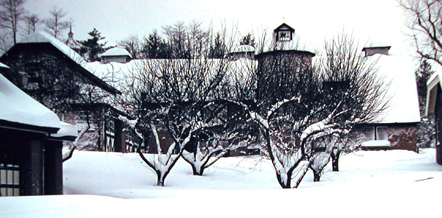
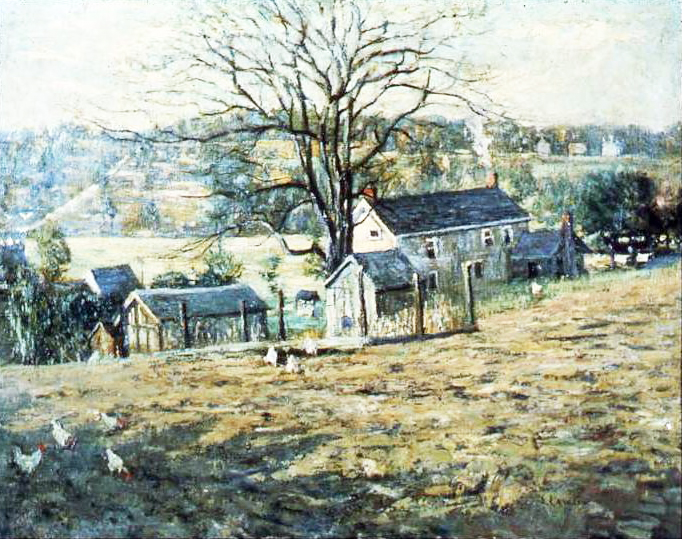
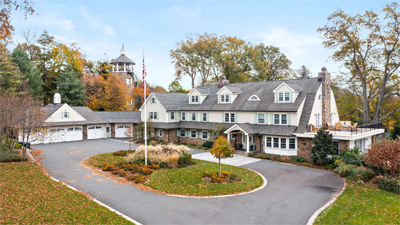
OnPorchSM.jpg)
